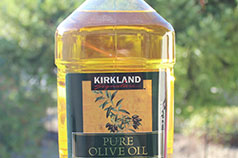
Olive Oil
Olive is one of the oldest known cultivated trees in the world. It is said that Olive trees are being cultivated before the invention of written language. Olive trees are draught tolerant and are native to eastern Mediterranean region. The trees can survive and bear fruits for a thousand year. Olives are small fruits of the Olive tree. During prehistoric time, people use to grind and drain the pulp of olives to get oil for cooking and lighting lamps. Oil extracted from olives was also used for cosmetic purposes.
Today, olive oil is popular than any other oil for culinary use and health benefits. About 90% of the olive fruit produce goes toward the production of olive oil. The oil is produced by pressing the whole olives and is used for cooking, cosmetics, pharmaceutical uses, and as fuel for certain lamps.
Olive oil used for cooking and eating is broadly classified as extra virgin, virgin, pure, and light. The difference is mainly in the process of production of different verities, due to which they contain different levels of antioxidant and have different smoking point.
Extra virgin olive oil is the best quality and is extracted using mechanical process such as cold pressing and centrifugation. The olives are pressed at normal temperature without the use of heating and chemicals. This method of extraction helps preserve most of the antioxidants and hence, makes the oil of high quality. The extra virgin olive oil smokes at a very low temperatures ranging from 200 to 372 degree Fahrenheit depending upon the quality (the better the quality have higher smoking point). Therefore, extra virgin olive oil is considered cold dishes like salad dressing and dips as well as cooking at a medium heat. You can use the good quality extra virgin oil to sauté vegetables, shallow frying eggs, and meats. It’s not recommended to use extra virgin olive oil for deep frying at higher temperatures.
Virgin olive oil is extracted using the same process as extra virgin. It has same levels of monounsaturated fats, antioxidant, and has the similar smoking point. It’s different from extra virgin because it’s made using relatively ripe olives, which gives it light flavor. The usage of virgin oil for cooking is same as extra virgin oil.
Pure olive oil has the same monounsaturated fat content, but has less antioxidant. Pure olive oil, also called olive oil, is a blend of virgin oil and refined pomace oil (also called refined olive oil). Pomace oil, a leftover during the extraction of extra virgin and virgin oils, is refined before mixing it to the virgin oil. The blend contains only about 5 to 10% of virgin oil. It’s lighter in taste, and has higher smoking point that makes it fit for sautéing and frying.
Light olive oil has the same percentage of monounsaturated fat, but lowest level of antioxidants. It’s basically refined olive oil, manufactured by the using some chemical and heat to get rid of impurities. It’s smoking point is highest and is ideal for high temperature cooking, such as deep frying and baking.
At higher temperatures, required for deep frying, extra virgin and virgin oil lose their antioxidant properties and flavor. Therefore, many cooks use pure or light olive oil for frying. Some views suggest that cooking with extra virgin and virgin olive oil at high temperatures is harmful for health; however, there is no substantial evidence to support such views. This might be a myth or a truth. Therefore, to be on the safe side, it’s advisable to use pure and light olive oil for higher temperature cooking such as deep frying, and use good quality extra virgin and virgin olive oil for cold dishes and cooking at medium temperature such as sautéing.
Because of the higher monounsaturated fat content, all kinds of olive oil lasts longer than other oils. After opening, close the cap or lid completely and store in a cool, dark, and dry place, and use it within 3 – 4 months from opening. Due to the presence of antioxidant substances, extra virgin and virgin oils are more resistant to damage by oxygen in air. However, the chlorophyll in the oil makes them vulnerable to damage by light. Therefore, always store the extra virgin and virgin oil in a dark place away from light. Refrigeration slightly solidifies the oil, which comes back to its liquid state when kept at room temperature, but will lose its flavor.
Olive oil has high content of antioxidants called polyphenols, carotenoids, and tocopherols. It’s high in monounsaturated fat and has low saturated and polyunsaturated fat. This composition makes it healthy for heart and for prevention of many medical conditions like, cancer, high blood pressure, and diabetes. According to some recent research, consumption of olive oil improves calcium absorption; hence, prevents the onset osteoporosis.
You can buy olive oil at any grocery store. It is available at online grocery stores such as www.amazon.com. Type the kind of olive oil you want to buy on search bar, you will be able to choose from several options.
Today, olive oil is popular than any other oil for culinary use and health benefits. About 90% of the olive fruit produce goes toward the production of olive oil. The oil is produced by pressing the whole olives and is used for cooking, cosmetics, pharmaceutical uses, and as fuel for certain lamps.
Olive oil used for cooking and eating is broadly classified as extra virgin, virgin, pure, and light. The difference is mainly in the process of production of different verities, due to which they contain different levels of antioxidant and have different smoking point.
Extra virgin olive oil is the best quality and is extracted using mechanical process such as cold pressing and centrifugation. The olives are pressed at normal temperature without the use of heating and chemicals. This method of extraction helps preserve most of the antioxidants and hence, makes the oil of high quality. The extra virgin olive oil smokes at a very low temperatures ranging from 200 to 372 degree Fahrenheit depending upon the quality (the better the quality have higher smoking point). Therefore, extra virgin olive oil is considered cold dishes like salad dressing and dips as well as cooking at a medium heat. You can use the good quality extra virgin oil to sauté vegetables, shallow frying eggs, and meats. It’s not recommended to use extra virgin olive oil for deep frying at higher temperatures.
Virgin olive oil is extracted using the same process as extra virgin. It has same levels of monounsaturated fats, antioxidant, and has the similar smoking point. It’s different from extra virgin because it’s made using relatively ripe olives, which gives it light flavor. The usage of virgin oil for cooking is same as extra virgin oil.
Pure olive oil has the same monounsaturated fat content, but has less antioxidant. Pure olive oil, also called olive oil, is a blend of virgin oil and refined pomace oil (also called refined olive oil). Pomace oil, a leftover during the extraction of extra virgin and virgin oils, is refined before mixing it to the virgin oil. The blend contains only about 5 to 10% of virgin oil. It’s lighter in taste, and has higher smoking point that makes it fit for sautéing and frying.
Light olive oil has the same percentage of monounsaturated fat, but lowest level of antioxidants. It’s basically refined olive oil, manufactured by the using some chemical and heat to get rid of impurities. It’s smoking point is highest and is ideal for high temperature cooking, such as deep frying and baking.
At higher temperatures, required for deep frying, extra virgin and virgin oil lose their antioxidant properties and flavor. Therefore, many cooks use pure or light olive oil for frying. Some views suggest that cooking with extra virgin and virgin olive oil at high temperatures is harmful for health; however, there is no substantial evidence to support such views. This might be a myth or a truth. Therefore, to be on the safe side, it’s advisable to use pure and light olive oil for higher temperature cooking such as deep frying, and use good quality extra virgin and virgin olive oil for cold dishes and cooking at medium temperature such as sautéing.
Because of the higher monounsaturated fat content, all kinds of olive oil lasts longer than other oils. After opening, close the cap or lid completely and store in a cool, dark, and dry place, and use it within 3 – 4 months from opening. Due to the presence of antioxidant substances, extra virgin and virgin oils are more resistant to damage by oxygen in air. However, the chlorophyll in the oil makes them vulnerable to damage by light. Therefore, always store the extra virgin and virgin oil in a dark place away from light. Refrigeration slightly solidifies the oil, which comes back to its liquid state when kept at room temperature, but will lose its flavor.
Olive oil has high content of antioxidants called polyphenols, carotenoids, and tocopherols. It’s high in monounsaturated fat and has low saturated and polyunsaturated fat. This composition makes it healthy for heart and for prevention of many medical conditions like, cancer, high blood pressure, and diabetes. According to some recent research, consumption of olive oil improves calcium absorption; hence, prevents the onset osteoporosis.
You can buy olive oil at any grocery store. It is available at online grocery stores such as www.amazon.com. Type the kind of olive oil you want to buy on search bar, you will be able to choose from several options.
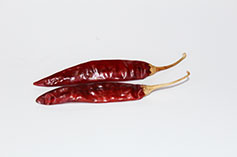
Whole Dried Red Chili
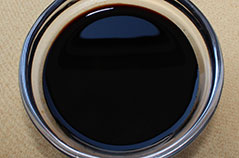
Soy Sauce
Coming Soon...

Sugar
Coming Soon...

Vinegar
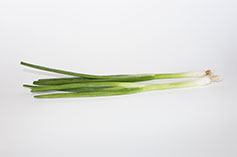
Scallion
Coming Soon...

Carrot
Coming Soon...

Ginger
Native to Southeastern Asia, Ginger is popularly used as a spice and medicine in both eastern and western cultures. Ginger was used by ancient Romans and later, after the fall of Roman Empire, was traded in Europe by Arabs who took over the spice trade. Ginger became very expensive like other spices, and in medieval times, was traded in preserved form to make sweet treats.
For many years, ginger has been used to flavor a wide variety of food, from meats and sausages to fish and vegetables, and various curries as well as drinks and desserts. Fresh ginger can be used as sliced, crushed, or as paste.
Ginger has antioxidant and anti-inflammatory properties; therefore, it’s used in traditional medicine to cure a variety of ailments, such as, gastrointestinal distress, motion sickness, arthritis, and cold and flu. Cooking food with small quantity of ginger on a regular basis also adds to health benefits.
The distinct flavor and medicinal property of ginger comes from gingerols, shogaols, and zingerone. Fresh ginger contains gingerol an anti-inflammatory compound that is believed to help in reducing osteoarthritis or rheumatoid arthritis pain, if consumed on a regular basis. It may also prevent growth of certain cancer. Gingerol is transformed into shogaols when dried and cooked. Also, when ginger is cooked gingerol and shogaols is transformed into zingerone. Due to the presence of zingerone, food cooked with ginger has a sweet and spicy flavor. The anti-inflammatory and antioxidant properties of zingerone help in prevention and cure of many medical problems. Dry ginger alone has strong flavor due to shogaols used in many medicines as well as compliments cookies, cakes, and candies recipes, and tea and drinks.
In addition to the use for culinary and medicinal purposes, ginger is also used to fragrance many soaps and cosmetics.
Ginger is sold in many forms in supermarkets, such as fresh, dried, powdered, preserved, crystallized, and as oil. You will find ginger paste, a popular way of using ginger to make curries in Asian countries, in Asian and South Asian grocery stores. Be sure to use ginger in the recipe in the form it’s advised. For example, if a recipe calls for fresh ginger, it cannot be replaced with dry or powdered or other types. Each form of ginger has a distinct taste and different purpose.
Ginger is best stored as whole and unpeeled in a sealed plastic bag in refrigerator. If part of the ginger has been cut or peeled, be sure to dry it before storing. Other forms of ginger are mainly packaged and need to be stored as per instructions by the seller.
For many years, ginger has been used to flavor a wide variety of food, from meats and sausages to fish and vegetables, and various curries as well as drinks and desserts. Fresh ginger can be used as sliced, crushed, or as paste.
Ginger has antioxidant and anti-inflammatory properties; therefore, it’s used in traditional medicine to cure a variety of ailments, such as, gastrointestinal distress, motion sickness, arthritis, and cold and flu. Cooking food with small quantity of ginger on a regular basis also adds to health benefits.
The distinct flavor and medicinal property of ginger comes from gingerols, shogaols, and zingerone. Fresh ginger contains gingerol an anti-inflammatory compound that is believed to help in reducing osteoarthritis or rheumatoid arthritis pain, if consumed on a regular basis. It may also prevent growth of certain cancer. Gingerol is transformed into shogaols when dried and cooked. Also, when ginger is cooked gingerol and shogaols is transformed into zingerone. Due to the presence of zingerone, food cooked with ginger has a sweet and spicy flavor. The anti-inflammatory and antioxidant properties of zingerone help in prevention and cure of many medical problems. Dry ginger alone has strong flavor due to shogaols used in many medicines as well as compliments cookies, cakes, and candies recipes, and tea and drinks.
In addition to the use for culinary and medicinal purposes, ginger is also used to fragrance many soaps and cosmetics.
Ginger is sold in many forms in supermarkets, such as fresh, dried, powdered, preserved, crystallized, and as oil. You will find ginger paste, a popular way of using ginger to make curries in Asian countries, in Asian and South Asian grocery stores. Be sure to use ginger in the recipe in the form it’s advised. For example, if a recipe calls for fresh ginger, it cannot be replaced with dry or powdered or other types. Each form of ginger has a distinct taste and different purpose.
Ginger is best stored as whole and unpeeled in a sealed plastic bag in refrigerator. If part of the ginger has been cut or peeled, be sure to dry it before storing. Other forms of ginger are mainly packaged and need to be stored as per instructions by the seller.
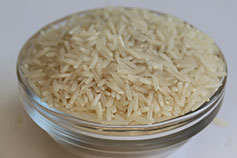
Cooked White Rice

Garlic Cloves
Native to central Asia, Garlic is one of the earliest plants that human used for flavoring food dishes as well as maintaining a good health. Garlic became an important ingredient in cooking many dishes in various parts of the world, such as, Asian countries including Middle East, northern Africa, southern Europe, and parts of South and Central America. However, Garlic was not popular in the USA until the beginning of twentieth century. By the year 1940, Americans recognized the importance of Garlic and started using it to season various recipes.
A Garlic bulb is a bunch of individual segments called cloves (like an orange segment). Each Garlic clove can be separated off the bunch and peeled before use to flavor any recipe. A Garlic clove can be used as a whole, sliced, crushed, or in the form of paste. Each way of using Garlic provides a different flavor to the recipes. For example, whole and sliced garlic provides mild taste than crushed and paste form.
Due to higher concentration of fructose and significantly less water content, Garlic is browned quickly when frying or roasting. Therefore, Garlic needs to be cooked carefully. If you are cooking food in a pan or a wok, one way is to add Garlic toward the end of cooking, in the last few minutes. However, Garlic added at the end of the cooking will provide a stronger taste. Some people like it, some don’t. Cooking Garlic at the beginning will mellow down the strong taste. To add garlic at the beginning of cooking and yet prevent from burning, cook the Garlic at a low heat and preferably in a smaller pan or wok. You can change the heat from low to medium after adding other ingredients with garlic. Garlic cooked this way will provide mild taste to the food. Garlic is best roasted in an oven by wrapping the cloves or whole bulb in an aluminum foil at 400 degrees Fahrenheit for about 40 minutes.
Though garlic is best known for flavoring food, it has also been used to maintain good health and for increasing strength. Usage of garlic in food may also help prevent many heart and blood system related conditions, such as, high blood pressure, high cholesterol, and coronary heart disease. It’s also believed that consumption of garlic on a regular basis reduces the risk of getting certain cancer, such stomach cancer, colon cancer, and lung cancer. For maximum health benefits, slice, crush, or make garlic paste 10 minutes before cooking. When a garlic clove is broken down, the ruptured cell releases the sulphur-based compound, alliin and an enzyme called alliinase. They come in contact with each other to form a new compound called alliicin, which is responsible for medicinal properties of Garlic. Allowing the cut Garlic to sit for about 10 minutes before cooking provides maximum health benefits due to optimal synthesis of alliicin.
Whole fresh garlic should be stored at room temperature at dry and dark place with proper ventilation. Do not store garlic in closed plastic bags. It’s best to store garlic in netted or punched bags for better air circulation. Refrigeration or freezing changes the texture and flavor of garlic. However, cut or peeled garlic needs to sealed in a container or air tight bag and refrigerated for later use.
A Garlic bulb is a bunch of individual segments called cloves (like an orange segment). Each Garlic clove can be separated off the bunch and peeled before use to flavor any recipe. A Garlic clove can be used as a whole, sliced, crushed, or in the form of paste. Each way of using Garlic provides a different flavor to the recipes. For example, whole and sliced garlic provides mild taste than crushed and paste form.
Due to higher concentration of fructose and significantly less water content, Garlic is browned quickly when frying or roasting. Therefore, Garlic needs to be cooked carefully. If you are cooking food in a pan or a wok, one way is to add Garlic toward the end of cooking, in the last few minutes. However, Garlic added at the end of the cooking will provide a stronger taste. Some people like it, some don’t. Cooking Garlic at the beginning will mellow down the strong taste. To add garlic at the beginning of cooking and yet prevent from burning, cook the Garlic at a low heat and preferably in a smaller pan or wok. You can change the heat from low to medium after adding other ingredients with garlic. Garlic cooked this way will provide mild taste to the food. Garlic is best roasted in an oven by wrapping the cloves or whole bulb in an aluminum foil at 400 degrees Fahrenheit for about 40 minutes.
Though garlic is best known for flavoring food, it has also been used to maintain good health and for increasing strength. Usage of garlic in food may also help prevent many heart and blood system related conditions, such as, high blood pressure, high cholesterol, and coronary heart disease. It’s also believed that consumption of garlic on a regular basis reduces the risk of getting certain cancer, such stomach cancer, colon cancer, and lung cancer. For maximum health benefits, slice, crush, or make garlic paste 10 minutes before cooking. When a garlic clove is broken down, the ruptured cell releases the sulphur-based compound, alliin and an enzyme called alliinase. They come in contact with each other to form a new compound called alliicin, which is responsible for medicinal properties of Garlic. Allowing the cut Garlic to sit for about 10 minutes before cooking provides maximum health benefits due to optimal synthesis of alliicin.
Whole fresh garlic should be stored at room temperature at dry and dark place with proper ventilation. Do not store garlic in closed plastic bags. It’s best to store garlic in netted or punched bags for better air circulation. Refrigeration or freezing changes the texture and flavor of garlic. However, cut or peeled garlic needs to sealed in a container or air tight bag and refrigerated for later use.

Salt
Salt is a mineral composed of a chemical compound called sodium chloride. It is essential for human body to regulate fluid balance and to control function of nerves and muscles. Human body cannot produce its own salt and depends on various sources of salt in food for necessary daily intake.
In addition to being just a diet supplement, salt helps in extracting the real flavors of savory as well as sweet dishes. No other seasoning has been found so fulfilling to replace salt. However, the overuse of salt results into a lot of health problems, such as hypertension, heart disease, and strokes. Use salt mildly in your food to you can enjoy its goodness.
In addition to being just a diet supplement, salt helps in extracting the real flavors of savory as well as sweet dishes. No other seasoning has been found so fulfilling to replace salt. However, the overuse of salt results into a lot of health problems, such as hypertension, heart disease, and strokes. Use salt mildly in your food to you can enjoy its goodness.

Water
Coming Soon...

Celery

Cabbage
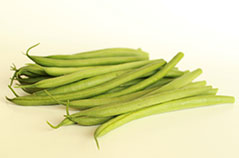
Green Beans
Coming Soon...
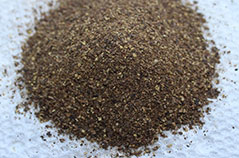
Black Pepper
Native to South India, black pepper, in whole or powdered or crushed form, is used as a spice or seasoning all over the world. In ancient times, black pepper was so expensive that it was used as a currency or collateral. Even today, black pepper is known as king of spices and is highly demanded spice around the world.
Black pepper powder is made by grinding the black peppercorns. Black peppercorns are made by picking the pepper berries when they are half ripe. Then they are dried in sun over a period of time, which causes them to shrivel and become dark in color. Because of their hard and shriveled texture, black peppercorns are easily ground in a pepper mill and taste best in this form. You can also powder the peppercorns by slightly roasting for 2-3 minutes and then grinding in a spice or coffee grinder (as always, do not use the same grinder for spices and coffee). As with all spices, roasting enhances the flavor of peppercorns. Buy peppercorns that are blemish free, heavy for their size, and compact.
Black pepper in any form is very flavorful and pungent and is used around the world to brighten the taste and aroma of a variety of dishes, from appetizers to desserts. In addition to enhancing the taste of food, it also acts as an appetite and taste buds stimulator and improves digestion. It acts as an antioxidant and is a good source of dietary fiber, vitamin K, and minerals such as iron and manganese.
Whole as well as ground/powdered black pepper is stored in air tight container in a cool, dark, and dry place. Black pepper powder can be stored at room temperature for 4-6 months while whole peppercorns last up to a year. You can also freeze them to last for up to 2 years.
Whole black peppercorns or powdered black pepper is available in any grocery store. You can also buy it at online grocery stores. My favorite is amazon.com. However, you can explore other online resource as well.
Black pepper powder is made by grinding the black peppercorns. Black peppercorns are made by picking the pepper berries when they are half ripe. Then they are dried in sun over a period of time, which causes them to shrivel and become dark in color. Because of their hard and shriveled texture, black peppercorns are easily ground in a pepper mill and taste best in this form. You can also powder the peppercorns by slightly roasting for 2-3 minutes and then grinding in a spice or coffee grinder (as always, do not use the same grinder for spices and coffee). As with all spices, roasting enhances the flavor of peppercorns. Buy peppercorns that are blemish free, heavy for their size, and compact.
Black pepper in any form is very flavorful and pungent and is used around the world to brighten the taste and aroma of a variety of dishes, from appetizers to desserts. In addition to enhancing the taste of food, it also acts as an appetite and taste buds stimulator and improves digestion. It acts as an antioxidant and is a good source of dietary fiber, vitamin K, and minerals such as iron and manganese.
Whole as well as ground/powdered black pepper is stored in air tight container in a cool, dark, and dry place. Black pepper powder can be stored at room temperature for 4-6 months while whole peppercorns last up to a year. You can also freeze them to last for up to 2 years.
Whole black peppercorns or powdered black pepper is available in any grocery store. You can also buy it at online grocery stores. My favorite is amazon.com. However, you can explore other online resource as well.
Share your thoughts and questions!


